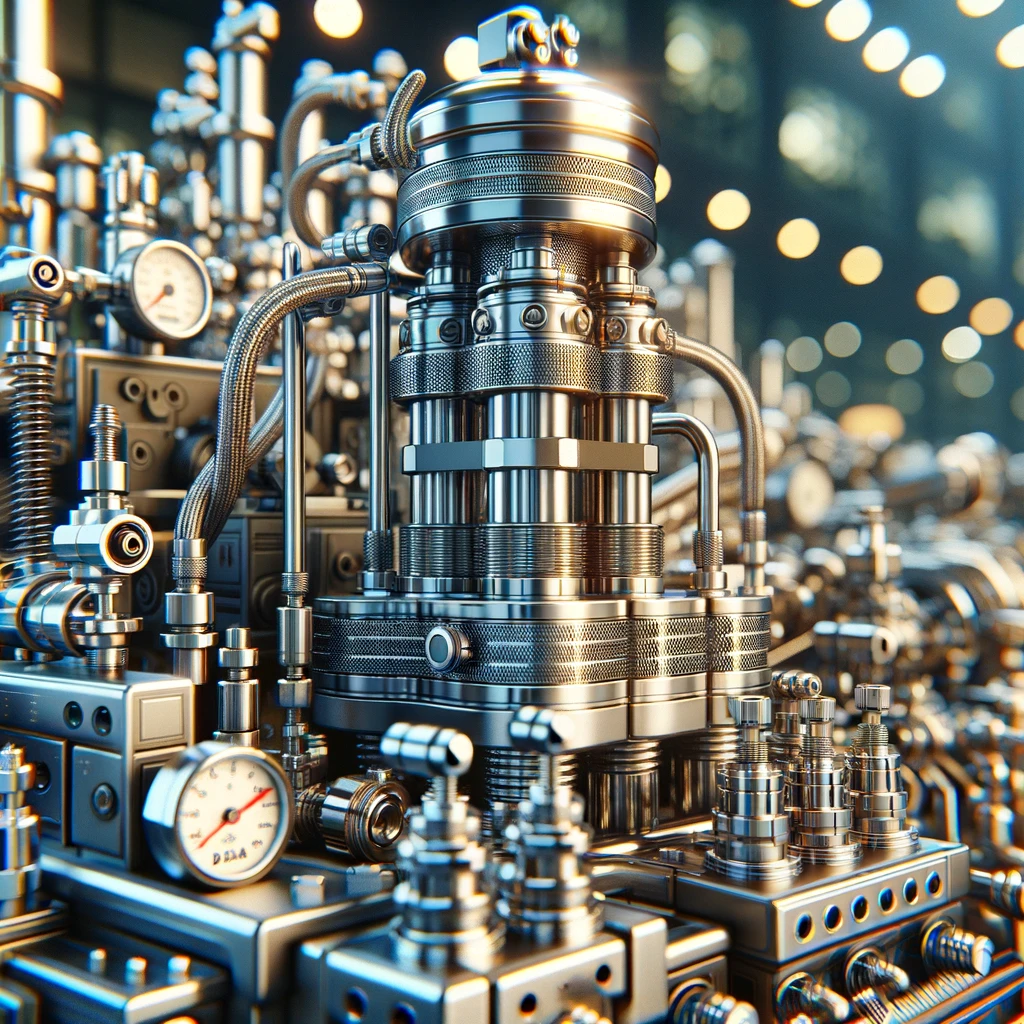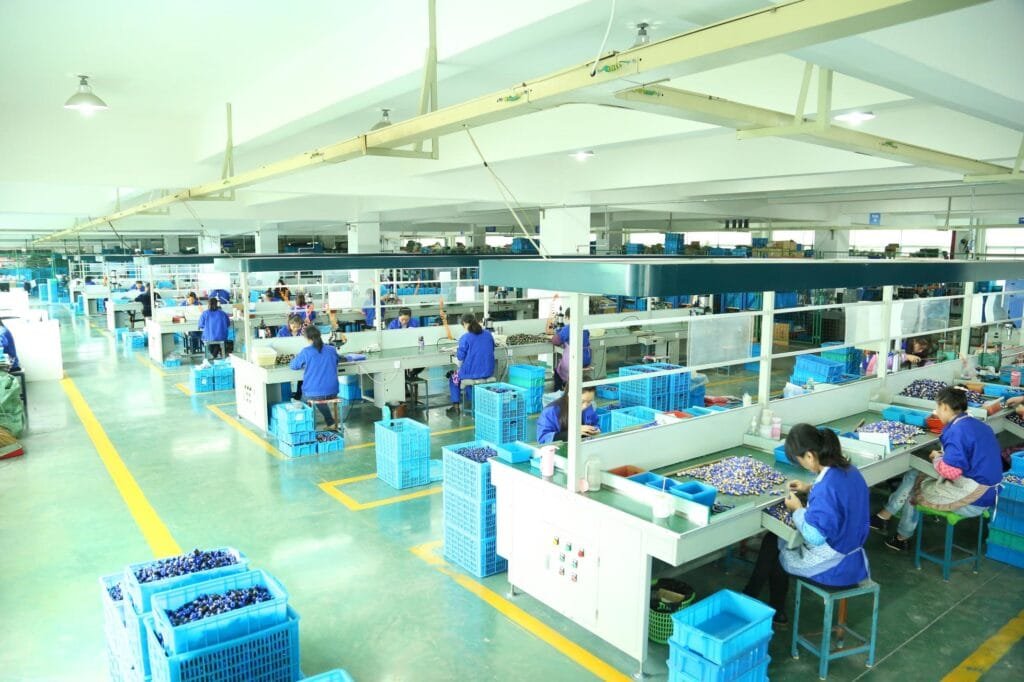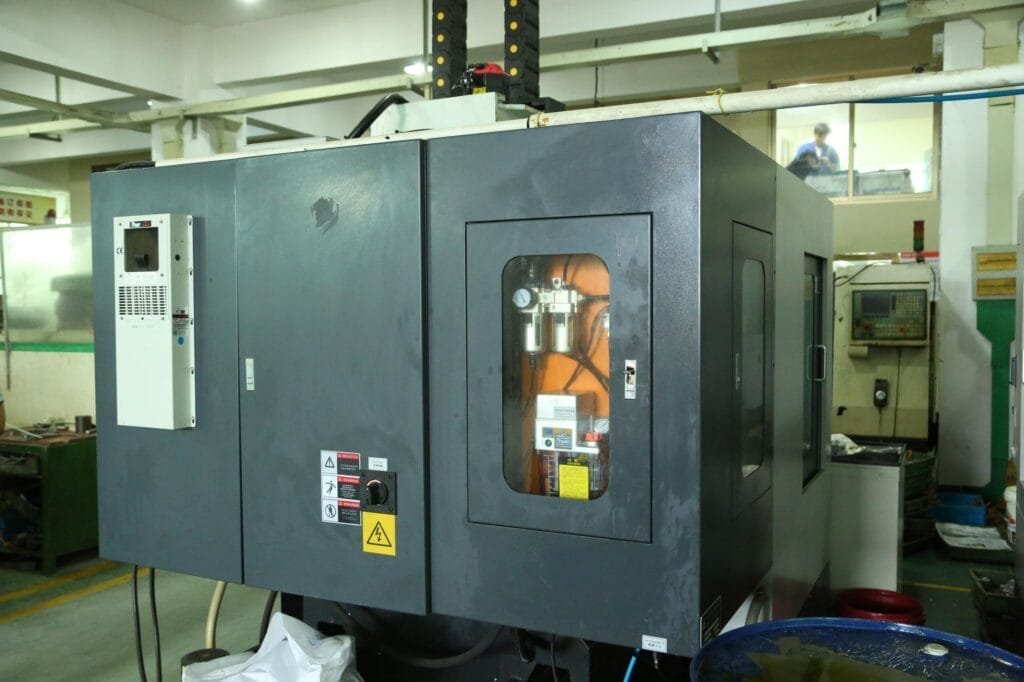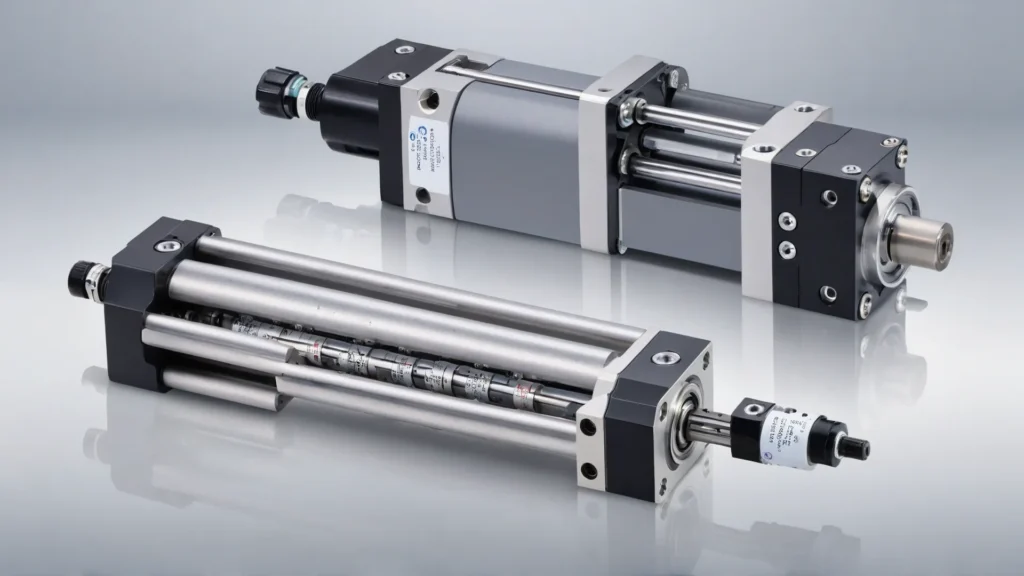What Is The Difference Between Hydraulic And Pneumatic Cylinder
Hydraulic cylinders use oil to transmit force, while pneumatic cylinders use compressed air for the same purpose. This results in hydraulic systems being able to exert greater force than pneumatic systems, albeit at a slower speed and higher cost.
Understanding the fundamental differences between hydraulic and pneumatic cylinders is crucial for selecting the right type of power transmission in various industrial applications. This guide aims to delineate these differences succinctly, aiding in informed decision-making for efficiency and effectiveness in machinery operations.
What Is Pneumatics
Pneumatics involves the use of compressed air to do work. Air from the atmosphere is drawn into a compressor, where it is compressed and then released to power tools or machinery. This system relies heavily on air as a clean, flexible, and safe resource.
Compressed air can be easily stored in tanks and transported through hoses and pipes. It provides a powerful force that can drive motors and actuators in various applications. Pneumatic systems are commonly found in industrial settings, powering equipment such as drills, hammers, and other manufacturing tools.

Advantages Of Pneumatics
Simplicity and Cost-Effectiveness
Pneumatic systems are simpler in design. They use air as their operating medium, which is freely available and easy to store. This simplicity translates to lower initial costs and maintenance expenses.
Safety
Air is non-flammable and non-toxic, making pneumatics a safer choice in hazardous environments. The risk of fire or explosion is minimal compared to hydraulic systems that use oil-based fluids.
Speed
Pneumatic cylinders can operate at high speeds because air can be exhausted quickly. This makes them ideal for applications requiring rapid movement.
Cleanliness
Since they use air, there’s no risk of leakage causing contamination. This is particularly important in industries where cleanliness is critical, such as pharmaceuticals or food processing.
Energy-Efficient
Pneumatics can be more energy-efficient for certain tasks because compressed air can be easily controlled and directed only where needed.
Disadvantages Of Pneumatics
Higher Operational Cost
Pneumatic systems incur a higher operational cost primarily because of the energy lost during the air compression process. A significant amount of the energy used in compressing air is dissipated as heat, making these systems less efficient compared to other power transmission methods.
Moisture Problems
As compressed air cools down, moisture condenses out of it, potentially causing water to accumulate in pneumatic lines and equipment. This moisture can lead to internal rust and corrosion, negatively affecting the system’s longevity and reliability.
Lower Force Capabilities
Pneumatic systems offer lower force and torque capabilities when compared to hydraulic systems, making them unsuitable for tasks that require high force or torque.
Less Precise Control
Due to the compressible nature of air, pneumatics offer less precise control over movements. This characteristic makes fine-tuning movements more challenging, particularly in applications demanding high precision.
Noise
Pneumatic systems generate noise through the exhaust of air under pressure, which can create uncomfortable or hazardous working conditions in environments where noise levels are a concern.
Environmental and Safety Concerns
While pneumatics use air as the medium and do not pose significant direct environmental hazards, indirect effects such as the energy consumption required for air compression should be considered.
Regular Inspection and Servicing Needs
Despite being simpler and generally easier to maintain than hydraulic systems, pneumatic components require regular inspection and servicing to prevent compressed air leakage, contributing to operational costs.

What Is The Hydraulic
Hydraulics use fluid power to perform work. Heavy construction vehicles are a common example. This system uses pressurized hydraulic fluid to power hydraulic machinery and equipment. A simple concept underpins hydraulics: force applied at one point is transmitted to another point using an incompressible fluid, typically oil.
The foundation of hydraulic systems is Pascal’s law. It states that a pressure change in an enclosed fluid is transmitted uniformly to all parts of the fluid and the walls of its container. This principle allows large forces to be generated with relatively little effort.
A hydraulic system primarily consists of three components: a pump, a motor, and a cylinder or actuator. The pump converts mechanical energy into hydraulic energy by moving the fluid in the system. The motor or actuator then utilizes this hydraulic energy, converting it back into mechanical energy to perform work such as lifting heavy loads or turning wheels.
Advantages Of Hydraulic
High Power
Hydraulic systems deliver a remarkable power-to-size ratio, allowing them to provide high power output while occupying less space. This compact efficiency is especially beneficial in applications where space constraints exist but a high power output is required.
Precise Control
The precision control offered by hydraulic systems is unmatched by pneumatic alternatives. This precise control is critical in applications such as industrial robotics and aircraft control mechanisms, where intricate movements are essential.
Higher Forces
Due to the incompressibility of fluids under pressure, hydraulic systems can transmit greater forces efficiently, without the energy loss commonly seen in systems based on compressible mediums like air.
Capability to Move Heavy Loads
Hydraulic systems excel in moving heavy loads with exceptional precision, thanks to their unique design that facilitates smooth and accurate control even under high load conditions.
Straightforward Maintenance
With a well-designed and properly maintained system, the maintenance of hydraulic systems can be straightforward. The closed-loop design helps in keeping external contaminants out, reducing wear and tear on the components.
Versatility
Hydraulic systems operate effectively in a wide range of temperatures and pressures, making them versatile and suitable for various industrial applications, from heavy construction equipment to precision machinery.
Enhanced Safety
Many hydraulic systems are designed with redundancy and fail-safes to ensure continued operation even if a part fails, enhancing the system’s safety and reliability during operation.
Reduced Environmental Impact
Modern hydraulic systems are designed to minimize environmental impact by reducing leaks and using biodegradable fluids. These advancements contribute to environmental sustainability without compromising system efficiency.

Disadvantages Of Hydraulic
Oil Leaks
Hydraulic systems face the risk of oil leaks, causing environmental pollution and safety hazards, necessitating strict guidelines for fluid management.
Bulkiness
Hydraulic setups are often heavier and larger than pneumatics, restricting their use in space-constrained or portable applications.
Cost
The initial setup and ongoing maintenance of hydraulic systems can be costly due to components and the need for frequent fluid changes and leak monitoring.
Temperature Sensitivity
Performance issues arise in extreme temperatures, with cold causing fluid thickening and heat reducing fluid effectiveness.
Contamination
System longevity and performance are at risk due to fluid contamination, which can damage parts even in minimal amounts.
Noise
The operation of hydraulic pumps and motors generates noise, potentially requiring mitigation in certain environments.
Specialized Repairs
Repairing hydraulic systems demands specialized expertise, leading to potential increases in downtime for complex issues.
Complexity
The complexity of designing and implementing hydraulic systems, considering various factors like fluid dynamics and material compatibility, can be challenging.
Fire Risk
The use of hydraulic fluids introduces a fire hazard, especially if leaks occur near ignition sources or under high-temperature conditions.
Similarities Between Hydraulic And Pneumatic Systems
Fluid Power Operation
Hydraulic and pneumatic systems both rely on the principle of fluid power, utilizing a liquid or gas respectively to transmit energy and generate power within a confined space.
Basic Components
Each system is composed of similar foundational elements, including a reservoir, a pump (or a compressor in pneumatics), valves, actuaries, and piping that work in concert to produce motion or force.
Pascal’s Law
Both hydraulic and pneumatic systems operate based on Pascal’s law, which dictates that pressure applied to any part of a confined fluid is transmitted uniformly throughout the fluid, enabling force amplification in these systems.

What Is The Difference Between Hydraulic And Pneumatic Cylinder
Medium Used
- Hydraulic Cylinder: Hydraulic cylinders function using fluids like oil as their operating medium.
- Pneumatic Cylinder: Pneumatic cylinders, in contrast, work using compressed air.
Force Generation and Precision
- Hydraulic Cylinder: These cylinders provide higher power density, making them capable of handling more significant loads and suitable for heavy machinery. The precision in hydraulic systems tends to be higher due to the incompressibility of fluids.
- Pneumatic Cylinder: Although they are less efficient when dealing with heavy loads, pneumatic cylinders exhibit some variation due to air’s compressibility.
Speed and Efficiency
- Hydraulic Cylinder: While these systems may not operate as fast as pneumatics, hydraulic cylinders tend to be more efficient under heavy loads due to their use of fluid.
- Pneumatic Cylinder: Due to the rapid movement of air, pneumatic systems operate with increased speed compared to hydraulic systems.
Installation and Maintenance
- Hydraulic Cylinder: Hydraulic systems often require complex setups due to their intricate fluid dynamics and call for frequent maintenance checks.
- Pneumatic Cylinder: In contrast, the installation and maintenance for pneumatic systems can be simpler and cost-effective.
Environmental Impact and Safety
- Hydraulic Cylinder: They can pose a risk of fluid leaks, leading to a possible environmental impact. Also, the high-pressure levels necessitate careful handling.
- Pneumatic Cylinder: Pneumatics are generally safer and more environmentally friendly. However, they can produce noise pollution during operation.
Hydraulic And Pneumatic Systems Examples
Examples in Heavy Machinery and Automotive Sector
- Hydraulic Systems: They are primarily used in heavy machinery like excavators and bulldozers, and also in significant mechanical tasks like hydraulic brakes in vehicles. Additionally, in the automotive sector, hydraulics are crucial for braking and power steering systems.
- Pneumatic Systems: These are prevalent in industrial applications like air compressors, pneumatic mail systems, and pneumatic drills. In the automotive field, pneumatics are vital for air brake systems in larger vehicles, including trucks and buses.
Examples in Manufacturing Plants and Construction Sites
- Hydraulic Systems: Manufacturing plants often deploy hydraulic presses for molding parts. Construction sites employ hydraulic machinery such as cranes and lifts for heavy material lifting.
- Pneumatic Systems: On the other hand, pneumatic devices in manufacturing plants help in sorting and moving smaller components quickly. At construction sites, pneumatic tools like jackhammers are common due to their abilities to perform quick, repetitive motions.
Examples in Assembly Lines and Entertainment Industry
- Hydraulic Systems: Assembly lines may operate hydraulic robotic arms for managing heavy lifting with precision. In the entertainment industry, smooth movements in animatronics are often made possible through hydraulics.
- Pneumatic Systems: For faster and more repetitive tasks on assembly lines, pneumatic robotic arms are preferred. In the entertainment sector, pneumatics are often used to power effects that require sudden bursts of air, like jumpscares or rapid movements.
Examples in Agriculture
- Hydraulic Systems: Tractors equipped with hydraulic attachments such as loaders showcase the strengths of hydraulic systems in providing power and control.
- Pneumatic Systems: On the contrary, pneumatic seeders serve as efficient agricultural tools due to their ability to disperse seeds rapidly over large areas.

How Do You Identify A Pneumatic Cylinder And Hydraulic Cylinder
Operating Medium
- Pneumatic Cylinder: These cylinders operate using air.
- Hydraulic Cylinder: In contrast, hydraulic cylinders function with the help of a liquid medium, such as oil.
Construction Material
- Pneumatic Cylinder: Generally, they are made from lighter materials such as aluminum.
- Hydraulic Cylinder: They usually consist of tougher materials like steel due to their ability to handle higher pressures.
Pressure Rating
- Pneumatic Cylinder: Pneumatic systems tend to operate at lower pressures.
- Hydraulic Cylinder: If the system is designed for high-pressure operation, it is likely a hydraulic cylinder.
Connections to Other Components
- Pneumatic Cylinder: These cylinders connect with air lines.
- Hydraulic Cylinder: Hydraulic cylinders, on the other hand, are connected to pumps and reservoirs via hoses for fluid circulation.
Typical Usage Environments
- Pneumatic Cylinder: Their usage is common in clean environments due to the low risk of harmful leaks.
- Hydraulic Cylinder: They are commonly seen in more demanding, rugged applications due to their robustness and power.
Size and Speed
- Pneumatic Cylinder: These cylinders are usually smaller and facilitate faster movements due to the easy compressibility of air.
- Hydraulic Cylinder: By comparison, hydraulic cylinders, capable of higher force output, generally tend to be larger in size.
Can You Use A Hydraulic Cylinder With Air
Using a hydraulic cylinder with air is technically possible, but not ideal. Hydraulic cylinders are designed for hydraulic fluid, not air. Fluid is incompressible, leading to more precise control. Air compressibility makes for less precise control.
Can You Use A Pneumatic Cylinder As A Hydraulic Cylinder?
Using a pneumatic cylinder as a hydraulic cylinder is generally not advisable. Pneumatic cylinders are designed for air, while hydraulic cylinders are designed to handle fluids under higher pressure.
While both pneumatics and hydraulics execute similar functions — converting fluid pressure into mechanical force — their operational parameters differ markedly. In essence, substituting one for the other without accommodating these differences can result in inefficiency, equipment damage, or even pose safety hazards.
Why Would A Pneumatic System Be Used Instead Of A Hydraulic System?
Pneumatic systems use compressed air for power. They are chosen over hydraulic systems for several reasons. These systems are cleaner, as they don’t rely on oil or other fluids that could leak and cause contamination. This makes pneumatics preferable in industries where cleanliness is paramount, like food processing or pharmaceuticals.
Installation of pneumatic systems tends to be simpler and more cost-effective. Air is readily available and can easily be compressed and used, reducing initial setup costs compared to hydraulic systems that require a supply of fluid, reservoirs, and often more complex piping.
Pneumatics offer better safety due to the compressibility of air. In case of a leak, compressed air disperses quickly into the atmosphere without causing harm or environmental damage. Conversely, hydraulic oil leaks can pose slip hazards and contaminate workspaces or the environment.
These systems provide faster movement speeds compared to hydraulics. The rapid compression and expansion of air allow for quicker response times in machinery, which is beneficial in applications requiring high-speed operations.
Maintenance and operation costs are generally lower with pneumatics. Air systems do not need fluid replacements or deal with issues like fluid disposal, making them less costly to maintain over time.
For jobs demanding precise control at slower speeds under very high pressure, hydraulics might still be preferred. However, for many applications prioritizing safety, cleanliness, speed, ease of maintenance, and cost-efficiency, pneumatic systems offer clear advantages over hydraulic ones.
In Conclusion
In summary, while both hydraulic and pneumatic cylinders convert fluid or air pressure into mechanical motion, they differ significantly in terms of the medium used, power output, application environments, and operational efficiency.
To learn more about the optimal uses and advantages of hydraulic and pneumatic systems for your specific industrial requirements, we invite you to explore further with our range of detailed guides and professional advice. Don’t miss the opportunity to enhance your system’s efficiency by understanding these critical differences—contact us today for expert guidance and support.



